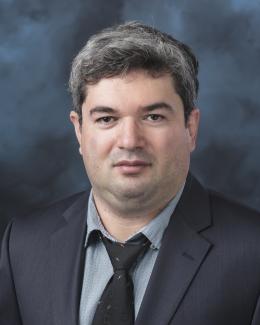
This multicomponent system enables structural, compositional, and electronic studies of surfaces and thin films, particularly oxides, in a highly controlled environment. Nanometer mapping of conductivity, piezoelectricity, work function and magnetism can be made over a range of temperatures without exposure to atmosphere following growth.
Science Overview
The CNMS NanoTransport system, consists of three ultrahigh (UHV) vacuum chambers, connected for sample transfer without external exposure. This unique feature provides the ability to characterize newly grown or cleaved materials in a carefully controlled environment without surface contamination.
The first chamber combines pulsed laser deposition (PLD) with differentially pumped reflection high-energy electron diffraction (RHEED), for highly controlled, layer-by-layer growth of oxide films at elevated temperatures in an oxygen atmosphere. This combination of PLD and RHEED has become known as Laser MBE and allows quality and number of layers to be monitored during deposition of multicomponent materials.
The second chamber of the system houses equipment for surface analysis including electron spectroscopies (X-ray photoemission, Auger electron, and Ultraviolet photoemission spectroscopies (XPS, AES, UPS)), and low energy electron diffraction (LEED). This chamber also provides surface preparation by sputtering, molecular beam epitaxy (MBE) deposition, and controlled gas exposure.
The third chamber adds an Omicron variable temperature scanning tunneling/atomic force microscope (STM/AFM) for atomically resolved images of surfaces. The microscope has been modified at ORNL for advanced imaging techniques including piezoresponse force microscopy (PFM) and band excitation methods.

LaxCa1-xMnO3 is a perovskite oxide, highly studied for its correlated electron physics, including colossal magnetoresistance and emergent conductivity. The NanoTransport system was used to study growth of La5/8Ca3/8MnO3 films using pulsed laser deposition (PLD) monitored with reflection high energy electron diffraction (RHEED) and in situ surface studies using STM and LEED. The data suggest that the out-of-plane lattice parameter is dependent on the mechanism of epitaxial strain relaxation, which is controlled by the oxidative power of the deposition environment. Crystal Growth & Design 16, 2708 (2016).

The peculiar interplay between spin-orbit effects, electron-electron interaction, and lattice produces an elaborate phase diagram for the 4d5 transition metal layered compound α-RuCl3, which could host novel exotic quantum phases, such as a room temperature quantum spin Hall effect and Kitaev quantum spin liquid (QSL) behavior. In parallel with neutron scattering studies of the bulk, the NanoTransport system was used to examine the surface. Samples were cleaved in vacuum to prepare a pristine surface and imaged using STM. A striking anisotropy was observed in the charge distribution along the Ru-Cl-Ru hopping paths, indicating that the bond-dependent behavior in this system may appear at temperatures considerably higher than the estimated strength of the Kitaev coupling. In addition, an unexpected charge ordered state was observed, characterized by a coexistence of trigonal-like and dimer-like patterns of charge disproportionation at the Cl terminated surface. Nature Communications 7, 13774 (2016)
Specifications
General
- Samples must be UHV compatible, able to be mounted on a metal transfer plate and relatively flat
- Sample size up to 12x12 mm2
- Inserted sample surfaces can be prepared by cleaving, inert gas sputtering or heated in vacuum or O2
Growth
- Pulsed Laser Deposition at 248 nm with fluence from 500-3000 mJ/cm2
- Growth in pressures up to 760 mtorr O2
- Reflection High Energy Electron Diffraction (RHEED), 20 kV beam operated at O2 pressures up to 100 mTorr during deposition
- IR sample heating during growth from 300-1000°C
- Sample annealing in oxygen
- Techniques for amorphous SrRuO3 conductive grounding
STM/AFM
- Omicron VT-STM/STS/AFM
- Beam deflection AFM allows PFM, cAFM, MFM, cKPFM, KPFM modes
- CNMS Band Excitation operation for PFM, cKPFM
- Temperatures from 100-450K
- STM requires a conductive path to ground
- Note that specific positioning of the AFM/STM tip on the sample (to less than ~250um) is not possible.
Surface Prep/Analysis
- Electron analysis with a Phoibos 150 Analyzer
- XPS sources: Al, Mg, or Monochromatic Ag, Al
- UPS sources: He I, He II
- Low energy charge compensation for poor conductors
- Temperatures from 100-1400K, or 100-650K during spectroscopy
- Temperature measurement by optical pyrometer
- Low energy electron diffraction
- MBE single metal sources
- Controlled gas exposures



